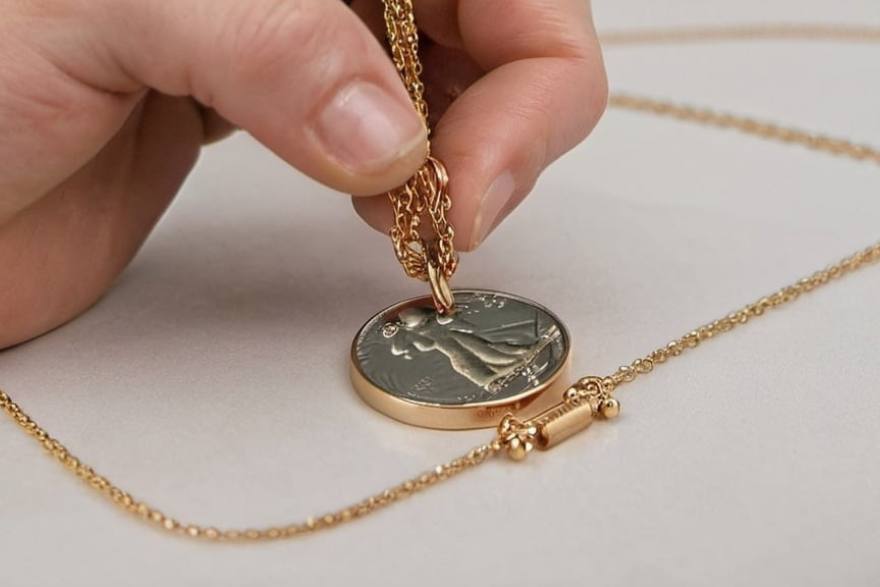Is That Monet Necklace Really Gold? Here’s How to Find Out!

As an Amazon Associate, I earn from qualifying purchases
You know, I’ve always been a sucker for vintage jewelry. There’s something about the history and craftsmanship that speaks to me. Recently, I stumbled upon a gorgeous Monet necklace at a flea market, and I couldn’t resist picking it up. But as I stood there, fingering the delicate chain, a nagging question popped into my head: “Is this gold?”
If you’ve ever found yourself in a similar situation, wondering about the authenticity of a Monet necklace, you’re not alone. Monet jewelry has been around for decades, and while they’re known for quality costume pieces, some of their designs use real gold. So, how can you tell the difference? Let me share what I’ve learned through my own experiences and research.
The History of Monet Jewelry
Before we dive into the nitty-gritty of gold identification, let’s take a quick trip down memory lane. Monet started as a Monocraft company in 1927, founded by brothers Michael and Joseph Chernow. They began by making monogrammed bags but soon shifted to jewelry production.

I remember my grandmother telling me how Monet became a household name in the 1950s and ’60s. They were known for their high-quality costume jewelry that often mimicked the look of fine jewelry. But here’s the kicker – while most of their pieces were gold-plated or used other materials, they did produce some solid gold items over the years.
Hallmarks: Your First Clue
When I’m examining a piece of Monet jewelry, the first thing I do is look for hallmarks. These tiny stamps can tell you a lot about a piece’s composition. Here’s what to keep an eye out for:
I once found a Monet necklace with a “14K” stamp at an estate sale. My heart started racing – could it be real gold? Well, the stamp was a promising start, but I knew I needed to dig deeper.
The Magnet Test
One of my favorite quick tests for gold is the magnet test. It’s simple, and you can do it right in the store if you’re shopping. Here’s how it works:
Gold is not magnetic. If your Monet necklace sticks to a magnet, it’s not solid gold. However, keep in mind that gold-plated items might not stick either, as the base metal could be non-magnetic.
I always carry a small magnet in my purse for impromptu jewelry testing. You should see the looks I get when I whip it out at flea markets!
The Weight Game
Real gold has a specific weight to it. When I hold a solid gold piece, it feels substantial for its size. If your Monet necklace feels unusually light, it’s probably not solid gold.

To give you an idea, here’s a quick comparison table I’ve put together based on my experiences:
Metal Type | Weight (per cubic cm) |
24K Gold | 19.3 grams |
14K Gold | 13.1 grams |
Gold-Filled | 10.9 grams |
Brass | 8.4 grams |
Remember, this is just a general guide. The actual weight of your necklace will depend on its size and design.
The Acid Test
If you’re serious about determining if your Monet necklace is real gold, you might want to consider an acid test. Now, I’ll be honest – the first time I did this, I was terrified I’d ruin my jewelry. But when done correctly, it’s a reliable method.
You’ll need to purchase a gold testing kit, which includes small bottles of acid for different karat levels. Here’s how it works:
- Make a tiny scratch on an inconspicuous part of the necklace.
- Apply a drop of acid to the scratch.
- Observe the reaction.
If the metal doesn’t react, it’s likely real gold of the karat you tested. If it turns green or another color, it’s not gold.
I remember the first time I did this test on a Monet necklace I thought might be gold. When the acid didn’t react, I felt like a proper jewelry detective!
The Color Conundrum: Is It Too Good to Be True?
Here’s something I’ve learned the hard way: if the color looks too perfect, be suspicious. Real gold, especially in vintage pieces, often has a slightly muted tone. If your Monet necklace has a super bright, yellow-gold color, it might be gold-plated rather than solid gold.
I once bought a Monet necklace that looked like the most perfect gold color I’d ever seen. Turns out, it was just really good quality gold plating. It’s still a beautiful piece, but not solid gold.
The Wear and Tear Tale
Vintage jewelry tells a story through its wear patterns. With gold-plated pieces, you might notice areas where the plating has worn away, revealing a different color underneath. Solid gold, on the other hand, wears more evenly.

I have a Monet bracelet that I’ve worn for years. The gold color has faded a bit, but it’s consistent all over. That’s one of the ways I know it’s real gold.
Seek Expert Opinion: When in Doubt, Ask a Pro
Sometimes, despite all our best efforts, it’s hard to be 100% sure about a piece of jewelry. That’s when I turn to the experts. A professional jeweler or appraiser can use more advanced methods to determine if your Monet necklace is real gold.
I once took a Monet necklace to a jeweler for appraisal. They used an X-ray fluorescence (XRF) analyzer to determine its exact composition. It turned out to be 14K gold, just as the stamp had indicated. It was fascinating to watch the process!
The Price Factor: Too Good to Be True?
Let’s talk about something that’s saved me from a few bad purchases: price. If you find a Monet necklace being sold as solid gold at a price that seems too good to be true, it probably is.
I remember spotting a “14K gold” Monet necklace at a price that made my eyes pop. But when I did the math, I realized it was being sold for less than the value of its gold content. That was a big red flag!
Research and Context: Know Your Monet
Understanding the context of your Monet necklace can provide valuable clues about its composition. Monet produced different lines of jewelry over the years, some more likely to contain real gold than others.
For example, their “Monhare” line, introduced in the 1980s, used 14K gold. If you have a piece from this collection, there’s a good chance it’s real gold.
I once found a Monet necklace from the Monhare line at an antique shop. The owner didn’t realize its potential value, but thanks to my research, I knew it was likely real gold. A few tests later, I had scored a genuine gold piece at a bargain price!
Conclusion
Determining whether a Monet necklace is real gold can be quite an adventure. It’s a mix of detective work, science, and a bit of intuition. While it might seem daunting at first, I’ve found that the process becomes easier (and more fun!) with practice.
Remember, even if your Monet necklace turns out not to be solid gold, it doesn’t diminish its beauty or historical value. Monet is known for creating stunning costume jewelry that has stood the test of time.
FAQs
Can all Monet jewelry be real gold?
No, not all Monet jewelry is real gold. Most Monet pieces are actually costume jewelry made with gold plating or other materials.
Is it safe to do an acid test on my Monet necklace at home?
While it’s possible to do an acid test at home, it requires caution and proper equipment. If you’re not experienced, it’s best to leave this test to professionals.
How can I tell the difference between a real vintage Monet piece and a modern reproduction?
Look for signs of age and craftsmanship. Authentic vintage Monet pieces often have a slight patina, and the craftsmanship is usually high quality. Check for correct hallmarks – vintage pieces should have marks consistent with their era.
As an Amazon Associate, I earn from qualifying purchases
Discover more from Fashion Guide
Subscribe to get the latest posts sent to your email.





